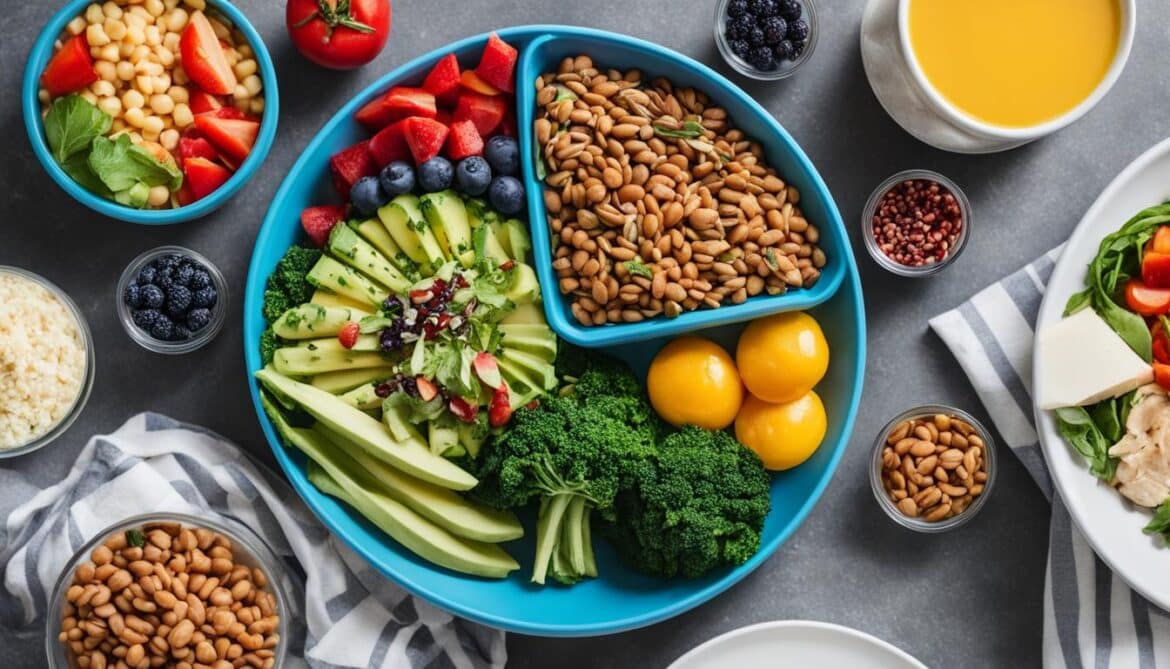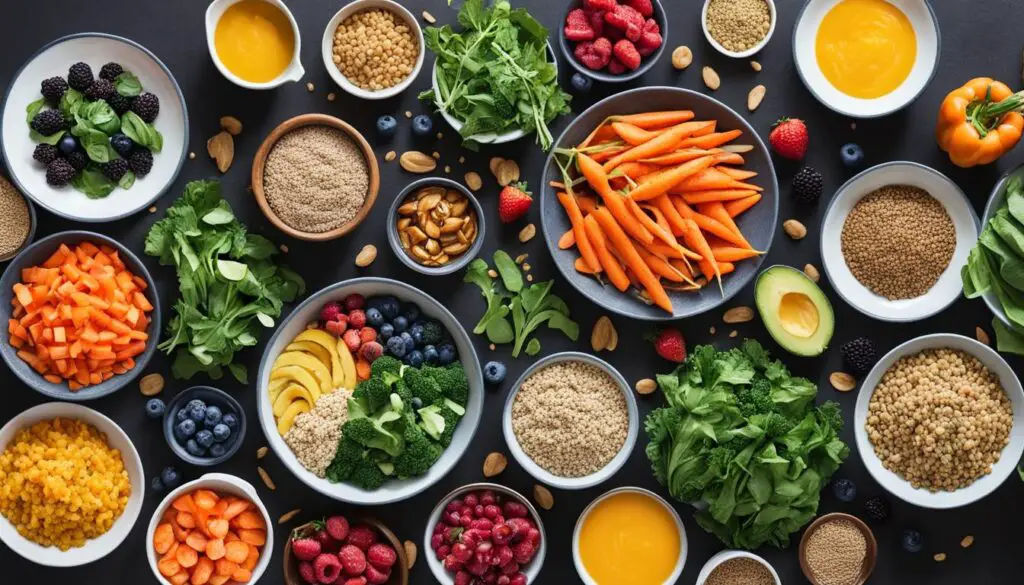Creating a weight loss meal plan doesn’t have to be expensive. By following low-cost meal plans, you can achieve your weight loss goals without breaking the bank. The key is to focus on nutritious, budget-friendly foods that will help you stay satisfied and energized while also promoting weight loss.
When it comes to weight loss, it’s important to set realistic goals. Instead of aiming for rapid and unsustainable weight loss, I recommend focusing on gradual and steady progress. This not only promotes long-term success but also helps you avoid feelings of deprivation and frustration.
Meal planning is a crucial aspect of creating low-cost weight loss meal plans. Start by making a list of affordable, nutrient-dense foods that fit within your budget. Plan your meals for the week and make a shopping list based on these ingredients. Look for sales, discounts, and bulk options to further reduce costs.
When creating low-cost weight loss meal plans, it’s important to choose ingredients that are both healthy and affordable. Opt for whole foods instead of processed and packaged items, as they tend to be more cost-effective and nutritious. Incorporate seasonal fruits and vegetables to take advantage of lower prices and maximize nutritional value.
An essential aspect of low-cost weight loss meal plans is finding simple and budget-friendly recipes. Look for recipes that require minimal ingredients and use pantry staples. One-pot meals, stir-fries, and sheet pan dinners are great options as they minimize cooking time and reduce the number of dishes to clean.
Creating low-cost weight loss meal plans is a practical and sustainable approach to achieving your weight loss goals. By setting realistic goals, planning budget-friendly meals, incorporating healthy ingredients, and using simple recipes, you can stay on track without compromising your budget or nutrition.
Key Takeaways:
- Follow low-cost meal plans to achieve weight loss goals on a budget.
- Set realistic weight loss goals for long-term success and avoid frustration.
- Plan your meals and make a shopping list based on affordable and nutritious ingredients.
- Choose healthy and affordable whole foods instead of processed and packaged items.
- Find simple and budget-friendly recipes that minimize cooking time and dish cleanup.
Setting Realistic Weight Loss Goals
When embarking on a weight loss journey, it is crucial to set realistic goals that you can achieve. Instead of aiming for rapid and unsustainable weight loss, focus on gradual and steady progress. This approach not only promotes long-term success but also helps you avoid feelings of deprivation and frustration. By setting achievable weight loss goals based on your individual circumstances, such as losing 1-2 pounds per week, you can create a sustainable low-cost meal plan that aligns with your objectives.
“Setting realistic goals is the first step towards achieving weight loss success. In my experience, clients who set attainable targets are more likely to stay motivated and committed to their weight loss journey.”
It’s important to remember that weight loss is not a linear process, and everyone’s journey is unique. Factors such as genetics, metabolism, and lifestyle play a significant role in your progress. By setting realistic goals, you give yourself the flexibility to adapt your meal plan and make necessary adjustments along the way.
When determining your weight loss goals, consider consulting with a healthcare professional or a registered dietitian. They can provide personalized guidance and support, taking into account your overall health, nutritional needs, and any medical conditions you may have.
Benefits of Setting Realistic Weight Loss Goals
There are several benefits to setting realistic weight loss goals:
- Increased motivation and a sense of accomplishment as you achieve smaller milestones along the way
- Improved compliance and adherence to your low-cost meal plan
- Reduced risk of burnout and frustration associated with overly ambitious goals
- Support for long-term success and maintenance of weight loss
By setting realistic weight loss goals, you are more likely to embrace a positive mindset and make sustainable changes to your eating habits and lifestyle. Remember, achieving your weight loss goals is a journey, and small and steady progress can yield significant results over time.
| Common Weight Loss Goals | Realistic Weight Loss Goals |
|---|---|
| Losing 20 pounds in 2 weeks | Losing 1-2 pounds per week |
| Fitting into a smaller dress size overnight | Achieving a gradual reduction in clothing sizes over time |
| Following a restrictive and unsustainable diet | Adopting a balanced and nutritious eating plan for long-term success |
Planning Budget-Friendly Meals
Meal planning plays a crucial role in creating low-cost weight loss meal plans. By carefully strategizing and preparing your meals in advance, you can save money without sacrificing nutritious options. Here are some tips to help you plan budget-friendly meals:
- Create a Shopping List: Start by making a list of affordable, nutrient-dense foods that fit within your budget. Include staples such as whole grains, lean proteins, fruits, vegetables, and legumes. This will ensure that you prioritize budget-friendly options while still meeting your nutritional needs.
- Plan Your Meals: Once you have your shopping list, plan your meals for the week. Take into account the ingredients you already have and incorporate them into your meal plan. This way, you can avoid unnecessary purchases and reduce food waste.
- Look for Sales and Discounts: Keep an eye out for sales, discounts, and special offers on the items you need. Check local grocery store flyers or websites for the best deals on your planned ingredients. Purchasing items on sale can significantly reduce your overall food costs.
- Consider Bulk Options: Buying in bulk is often more cost-effective, especially for pantry staples such as rice, pasta, and canned goods. Look for bulk options in your local grocery store or consider joining a wholesale club for discounts on larger quantities.
By planning ahead and sticking to your list, you can avoid impulse buying and unnecessary expenses, ultimately saving money while still enjoying delicious and nutritious meals.
Sample Budget-Friendly Meal Plan
| Meal | Monday | Tuesday | Wednesday | Thursday | Friday |
|---|---|---|---|---|---|
| Breakfast | Oatmeal with berries | Vegetable omelette | Yogurt with granola | Toast with avocado | Smoothie bowl |
| Lunch | Quinoa salad | Black bean wrap | Veggie stir-fry | Chickpea salad | Caprese sandwich |
| Dinner | Grilled chicken with roasted vegetables | Salmon with quinoa and steamed broccoli | Vegetable curry with brown rice | Turkey meatballs with zucchini noodles | Black bean chili |
This sample meal plan showcases a variety of budget-friendly meals that incorporate different food groups. Adjust the ingredients and portion sizes based on your personal preferences and dietary needs. Remember, meal planning can help you save money and stay on track with your weight loss goals.
Incorporating Healthy and Affordable Ingredients
When creating low-cost weight loss meal plans, it’s important to choose ingredients that are both healthy and affordable. Opt for whole foods instead of processed and packaged items, as they tend to be more cost-effective and nutritious. Use inexpensive protein sources like canned beans, lentils, eggs, and tofu. Incorporate seasonal fruits and vegetables to take advantage of lower prices and maximize nutritional value. Don’t forget to use herbs, spices, and homemade dressings to add flavor to your meals without spending extra money.
| Protein Sources | Fruits | Vegetables |
|---|---|---|
| Canned beans | Apples | Broccoli |
| Lentils | Bananas | Carrots |
| Eggs | Oranges | Spinach |
| Tofu | Strawberries | Kale |
By incorporating these healthy and affordable ingredients into your low-cost meal plans, you can create delicious and nutritious meals that support your weight loss goals without breaking the bank. Remember, achieving weight loss is not about depriving yourself, but rather making sustainable choices that promote overall health and well-being.
Simple and Budget-Friendly Recipes
An essential aspect of low-cost weight loss meal plans is finding simple and budget-friendly recipes. When you’re on a tight budget, it’s important to make the most of your ingredients and minimize waste. Look for recipes that require minimal ingredients and use pantry staples. This way, you can create delicious and nutritious meals without breaking the bank.
One-Pot Wonders
One-pot meals are a lifesaver when it comes to saving time and money in the kitchen. With just one pot or pan, you can create a complete and satisfying meal. Whether it’s a hearty soup, a flavorful stir-fry, or a comforting pasta dish, one-pot meals are budget-friendly and easy to prepare. Plus, they minimize the number of dishes you need to clean, making your mealtime even more convenient.
Repurpose and Reinvent
Don’t let leftovers go to waste! Get creative and repurpose ingredients to create new and exciting meals. For example, use leftover roasted chicken to make a delicious chicken salad or wrap. Transform yesterday’s roasted vegetables into a flavorful frittata or stir them into a hearty grain bowl. By repurposing leftovers, you can stretch your ingredients and reduce food waste, all while enjoying a variety of budget-friendly meals.
Tap into Online Resources
When it comes to finding budget-friendly recipes, the internet is your best friend. There is a wide range of online resources that provide affordable and healthy meal ideas to fit your weight loss goals and budget. Websites, blogs, and social media platforms are filled with recipes that focus on simplicity and cost-effectiveness. Additionally, there are plenty of recipe books available that offer a wide range of budget-friendly options.
Stick to Basics
Simplicity is key when it comes to creating budget-friendly meals. Stick to the basics and focus on using affordable ingredients. Whole grains, such as rice, oats, and quinoa, are not only nutritious but also budget-friendly. Opt for affordable protein sources like beans, lentils, and eggs. Seasonal fruits and vegetables are often more affordable and packed with flavor. By keeping your recipes simple and using basic ingredients, you can create delicious meals without breaking the bank.
Remember, a low-cost weight loss meal plan doesn’t have to be complicated. By utilizing simple and budget-friendly recipes, you can enjoy nutritious and satisfying meals without compromising your budget or weight loss goals.
Conclusion
Creating low-cost weight loss meal plans is a practical and sustainable approach to achieving your weight loss goals. By setting realistic goals, planning budget-friendly meals, incorporating healthy ingredients, and using simple recipes, you can stay on track without compromising your budget or nutrition.
Remember, weight loss is a journey, and it’s important to focus on long-term habits and lifestyle changes rather than quick fixes. By adopting the right mindset and implementing effective strategies, you can successfully lose weight while sticking to a low-cost meal plan.
So, start by setting achievable weight loss goals for yourself. Plan your meals based on affordable, nutrient-dense foods and take advantage of sales and bulk options to reduce costs. Choose whole foods, inexpensive protein sources, and seasonal fruits and vegetables to maximize nutrition and minimize expenses. Embrace simple and budget-friendly recipes that require minimal ingredients and minimize waste.
With dedication and perseverance, you can achieve your weight loss goals without breaking the bank. Remember, every small step towards a healthier lifestyle counts, and by sticking to a low-cost meal plan, you’ll not only shed pounds but also improve your overall well-being.
FAQ
How can I set realistic weight loss goals?
When embarking on a weight loss journey, it’s important to set realistic goals. Instead of aiming for rapid and unsustainable weight loss, focus on gradual and steady progress. Set achievable weight loss goals based on your individual circumstances, such as losing 1-2 pounds per week.
How can I plan budget-friendly meals?
Meal planning is a crucial aspect of creating low-cost weight loss meal plans. Start by making a list of affordable, nutrient-dense foods that fit within your budget. Plan your meals for the week and make a shopping list based on these ingredients. Look for sales, discounts, and bulk options to further reduce costs.
What ingredients should I choose for my low-cost weight loss meal plan?
When creating low-cost weight loss meal plans, it’s important to choose ingredients that are both healthy and affordable. Opt for whole foods instead of processed and packaged items. Use inexpensive protein sources like canned beans, lentils, eggs, and tofu. Incorporate seasonal fruits and vegetables to take advantage of lower prices and maximize nutritional value.
Are there any simple and budget-friendly recipes for weight loss?
Yes, there are plenty of simple and budget-friendly recipes available. Look for recipes that require minimal ingredients and use pantry staples. One-pot meals, stir-fries, and sheet pan dinners are great options as they minimize cooking time and reduce the number of dishes to clean. Get creative with leftovers and repurpose ingredients to minimize waste.
Source Links
- https://www.linkedin.com/pulse/ai-web-core-review-price-otos-truth-exposed-md-minhajul-islam-tyqoc?trk=article-ssr-frontend-pulse_more-articles_related-content-card
- https://www.eatingwell.com/dietitian-one-thing-doing-this-month-to-feel-my-best-8418512
- https://www.dailystar.co.uk/sport/football/maidstone-united-stevenage-fa-cup-31825668



